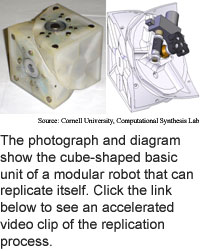
Machine reproduces itself
By
Eric Smalley,
Technology Research NewsOne of the defining distinctions between living beings and machines -- reproduction -- is beginning to crumble just a bit.
Researchers at Cornell University have built simple modular robots that are capable of reproducing themselves. The robots consist of motorized cubes that can swivel diagonally and connect to each other. Three- and four-cube machines follow simple rules to construct replicas of themselves using supplied cubes.
This form of self-replication is a far cry from animal reproduction and a long way from highly functional robots that reproduce, reconfigure and repair themselves, but it demonstrates that self-replication is not fundamentally biological and it points to the eventual possibility of truly autonomous machines.
The near-term benefit of the researchers' work is likely to be in advancing the field of modular robotics. Modular robots consist of autonomous parts that can connect to each other in different configurations to better handle specific tasks or changing conditions. (See "Self-configuring robot mimics lifeforms", TRN January 24, 2001)
Modular robots can also repair themselves by replacing damaged modules. "We might see robots for long-term tasks like space missions composed of systems that can self-repair," said Hod Lipson, an assistant professor of mechanical and aerospace engineering and computer and information science at Cornell.
The Cornell machines, dubbed Molecubes, measure 10 centimeters to a side and are split diagonally. Each cube half swivels on a motorized axel in 120-degree increments. The cube faces have electromagnets that strengthen and weaken to make and break connections with other cubes, and contacts that transfer communications and power between cubes.
The machines are powered through a base plate mounted on the floor of their enclosure, and they receive new cubes that the researchers place by hand in specific locations. Stacks of three and four cubes can assume a variety of shapes and, by following rules governing when and how to move after each contact with another cube, three- and four-cube machines can build copies of themselves. A three-cube machine takes just over a minute to reproduce; a four-cube machine takes two and a half minutes.
The researchers have also produced software simulations that show that self-replication is possible with larger numbers of cubes. The simulations were of seven- and eight-cube machines whose shapes and controllers were generated by an evolutionary algorithm, said Lipson.
With the addition of functional modules such as manipulators, cameras, and empty cargo-carrying blocks, the machines could eventually perform useful tasks, Lipson said.
The researchers have also developed a mathematical theory for measuring the self-replication capabilities of a system. The theory compares the probability of a system appearing spontaneously in an environment to the probability of its appearing when a copy of the system already exists. The theory considers the number of basic building blocks, the number of building block types, and their complexity. "Self-replication is not a binary property that a machine has or does not have, rather it is a continuum," Lipson said. "You can start with simple self-replication and improve it with increasingly complex machines," he said.
In 2000, Lipson and Brandeis University computer scientist Jordan Pollock combined a genetic algorithm that honed the design of robots in simulation with a rapid-prototyping machine that constructed the robots' parts (see "Robots emerge from simulation", TRN September 20, 2000). Lipson is aiming to eventually combine the automatic design and automatic fabrication capabilities from that project with the self-replication capability of the current project, he said.
The main challenges to making the process practical are miniaturizing the components, developing communications algorithms to coordinate the smaller components, and devising means of powering the smaller machines, said Lipson. "We are aiming to explore how to make these machines smaller and more numerous so we can study self-replication on a larger scale," he said.
Self-replicating machines could pose a risk to humans and the environment by slipping away from human control, over populating, and consuming resources. There is little to be concerned about at this stage of their development, however, said Lipson. Today's computer viruses and genetically modified crops, which are also forms of artificial self-replication, pose greater risks, he added.
Self-replicating machines could become practical in 10 to 20 years, said Lipson.
Lipson's research colleagues were Victor Zykov, Efstathios Mytilinaios and Bryan Adams. They published the research in the May 12, 2005 issue of Nature. The research was funded by Cornell University.
Timeline: 10-20 years
Funding: University
TRN Categories: Robotics
Story Type: News
Related Elements: Project web site: ccsl.mae.cornell.edu/self_replication; Technical paper, "Self-reproducing machines," Nature, May 12, 2005
Advertisements:
May 18/25, 2005
Page One
Stories:
Machine reproduces itself
Conference system makes shared space
Nanotube memory scheme is magnetic
How It Works: Robot navigation
Briefs:
Nanoparticles drive display
Thin silver sheet makes superlens
Catalyst boosts gasoline fuel cells
Virtual DNA makes material

Video clip
News:
Research News Roundup
Research Watch blog
Features:
View from the High Ground Q&A
How It Works
RSS Feeds:
News
Ad links:
Buy an ad link
| Advertisements:
|
 |
Ad links: Clear History
Buy an ad link
|
TRN
Newswire and Headline Feeds for Web sites
|
© Copyright Technology Research News, LLC 2000-2006. All rights reserved.